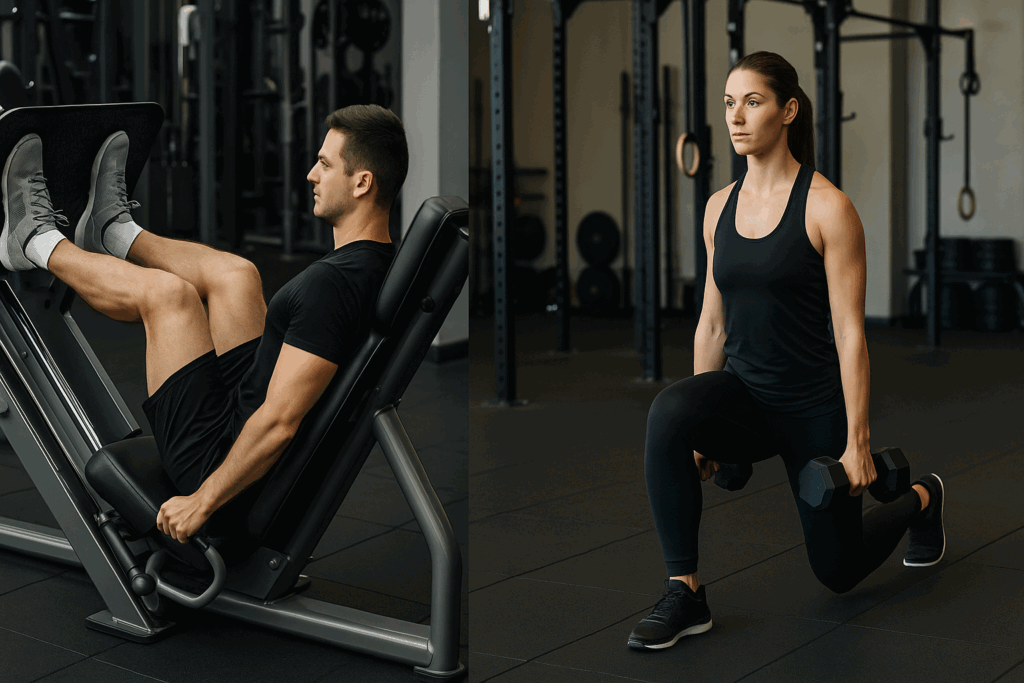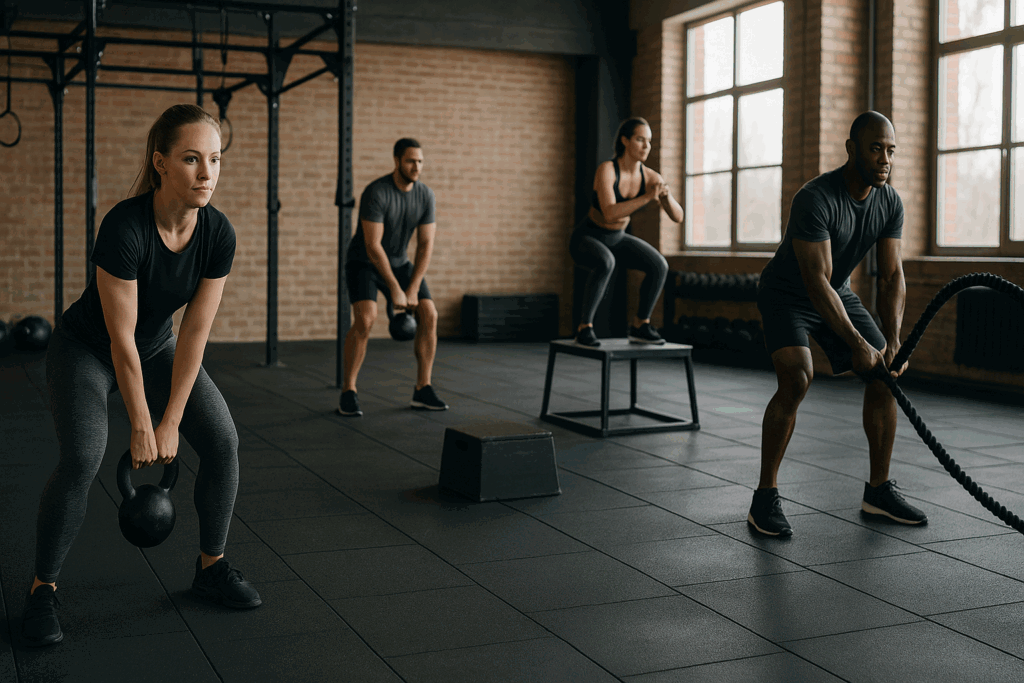Introduction
Functional training has revolutionized the modern fitness landscape, offering a holistic approach that goes beyond traditional exercise routines. Unlike isolated weightlifting or repetitive cardio sessions, functional training focuses on movements that mimic real-life activities. This emphasis on practical strength, balance, and coordination is key for both athletes and individuals seeking a healthier, more dynamic lifestyle. The essential functional training circuit for maximum endurance and cardio boost captures this philosophy perfectly, blending full-body functional movements with cardiovascular challenges that promote not just strength, but resilience and adaptability.
You may also like: 10 Minute Cardio Exercise: The Powerful Fat-Burning Routine You Can Do Anywhere
Combining endurance and cardio elements in fitness routines is vital for achieving optimal health and performance. Endurance exercises strengthen the heart and lungs, improve circulation, and increase the body’s capacity to sustain prolonged activity. Cardio-focused training, meanwhile, sharpens energy efficiency and metabolic flexibility, directly translating to better performance in everything from daily tasks to athletic competitions. When these components are seamlessly integrated into a functional training circuit, the result is a workout that supports a comprehensive foundation for fitness.
The concept of a functional training circuit is designed to challenge the entire body while maintaining the fluidity and adaptability of real-world movements. It leverages the best functional training principles, ensuring that no muscle group is left behind and that each exercise contributes to an interconnected web of strength and endurance. In the sections that follow, we’ll explore the principles of functional training, delve into the synergy of endurance and cardio within this approach, and provide a detailed roadmap for creating a transformative functional training circuit that elevates both physical capacity and overall well-being.

Understanding Functional Training
At its core, functional training is an approach to fitness that prioritizes movements reflecting the demands of daily life and sports. It trains the body to work as a unit, rather than isolating specific muscles in a rigid fashion. Exercises typically involve multiple joints and muscles simultaneously, promoting coordination, balance, and core stability. In a functional training circuit, this translates to exercises like squats, lunges, push-ups, and dynamic movements that mimic reaching, bending, or twisting motions.
The definition and principles of functional training distinguish it from more traditional workouts. While traditional strength training often focuses on hypertrophy and the aesthetic of individual muscles, functional training looks at how those muscles interact during real-world activities. Key principles include multi-planar movement, meaning exercises that engage the body across all planes of motion—sagittal, frontal, and transverse—rather than a single direction. It also emphasizes core engagement and the development of proprioception, the body’s ability to sense its position in space.
When comparing functional training to traditional workouts, the differences become clear. Traditional gym routines may involve seated machines that isolate the biceps or quadriceps, for example, but these do not always translate to improved performance in daily activities. In contrast, functional exercises challenge the body in standing, dynamic positions, requiring balance and stability throughout the movement. This not only enhances functional strength but also cultivates a body that is more injury-resistant and agile.
The benefits of functional training extend far beyond the confines of the gym. For instance, performing functional exercises like single-leg deadlifts or medicine ball rotations can directly improve one’s ability to carry groceries, lift children, or maintain good posture at a desk. In essence, a functional training circuit conditions the body for the rigors of real life, making it an essential part of any well-rounded fitness program. By understanding these principles, individuals can better appreciate how functional training circuits create the foundation for enduring strength and cardiovascular health.

The Role of Endurance and Cardio in Functional Training
Cardiovascular endurance is a cornerstone of overall health, impacting everything from daily energy levels to long-term disease prevention. It refers to the body’s ability to sustain exercise for extended periods, primarily through efficient heart and lung function. Functional training circuits that incorporate endurance exercises can significantly improve cardiovascular capacity, making activities such as climbing stairs, hiking, or even extended workdays feel more manageable and less taxing.
Functional training enhances cardiovascular health in a unique and powerful way. Because functional exercises recruit multiple muscle groups and involve dynamic, often full-body movements, they create an environment in which the heart must pump more vigorously to meet the demands of the muscles. This not only strengthens the heart but also trains it to work more efficiently under a variety of conditions. A well-designed functional training circuit for maximum endurance and cardio boost leverages this by blending high-intensity movements with controlled, deliberate exercises that keep the cardiovascular system fully engaged.
The synergy between endurance exercises and functional movements is where the real magic happens. Traditional cardio activities, such as running or cycling, build endurance through repetitive, rhythmic motion. However, when these principles are integrated into functional exercises—like jump squats, mountain climbers, or kettlebell swings—the result is a dynamic interplay between muscle and cardiovascular systems. This synergy ensures that the workout remains challenging and engaging, while also providing the metabolic benefits of high-intensity cardio training.
Moreover, this approach allows for continuous adaptation and progress. As cardiovascular endurance improves, the functional training circuit can be adjusted to include more complex movements or higher intensities. This not only sustains motivation but also ensures a consistent challenge for both the heart and the muscles. The integration of endurance and cardio into functional training circuits is a powerful tool for anyone looking to build not just a stronger body, but a body that can thrive in the demands of daily life.

Designing a Functional Training Circuit
Creating a functional training circuit that targets maximum endurance and cardio boost requires careful attention to exercise selection and sequencing. Key components include a balanced mix of compound exercises, dynamic movements, and exercises that challenge both strength and cardiovascular capacity. Each exercise should have a clear purpose, either to build foundational strength, enhance mobility, or increase heart rate in a safe and effective manner.
When selecting exercises, it’s important to choose those that engage multiple muscle groups and incorporate functional patterns. For example, exercises like burpees, which combine a squat, jump, and push-up, demand coordination and power while also providing a significant cardiovascular challenge. Similarly, medicine ball slams, battle rope exercises, and kettlebell swings are dynamic movements that engage the entire body and elevate the heart rate quickly. The best functional training circuits include a mix of these movements to ensure a full-body functional workout.
Balancing intensity and recovery is crucial in a functional training circuit. Too much intensity without recovery can lead to overtraining or injury, while too little intensity may not provide the desired cardiovascular or endurance benefits. A typical circuit might include 30 to 60 seconds of high-intensity work followed by 15 to 30 seconds of active recovery or rest. This interval structure helps maintain heart rate elevation, ensuring the cardiovascular system is continuously challenged throughout the workout.
In addition to exercise selection and intensity, the overall structure of the circuit matters. A well-designed functional training circuit should include a progression of movements that flow logically from one to the next, minimizing downtime and keeping the body in constant motion. This helps create the cardiovascular boost necessary for endurance gains while also engaging the muscles in functional patterns that improve daily performance. By adhering to these principles, individuals can craft a circuit that is both effective and enjoyable, laying the groundwork for long-term functional fitness and cardiovascular health.

Sample Functional Training Circuit for Endurance and Cardio
A successful functional training circuit begins with a comprehensive warm-up to prepare the body for the demands ahead. This warm-up should include dynamic stretches and mobility exercises that target key areas such as the hips, shoulders, and spine. Movements like hip circles, arm swings, and dynamic lunges prime the body’s joints and muscles, ensuring they are ready to handle the intensity of the workout. A proper warm-up not only improves performance but also reduces the risk of injury, a critical aspect of any functional fitness routine.
The main body of the circuit can include a variety of functional training exercises that elevate the heart rate while challenging the muscles in functional patterns. A sample circuit might start with alternating reverse lunges combined with a twist, targeting the core and legs while improving balance. This could be followed by push-ups with shoulder taps, engaging the upper body and stabilizing muscles. Kettlebell swings are a perfect addition, combining power, coordination, and cardiovascular demand into one fluid motion. Mountain climbers can be added to spike the heart rate further, while exercises like plank to pike movements integrate core and shoulder stability.
Each of these exercises should be performed for 30 to 60 seconds, with brief recovery periods in between to maintain intensity without sacrificing form. The goal is to keep the body in motion, forcing it to adapt and grow stronger with each repetition. The transitions between exercises are just as important as the exercises themselves, promoting continuous movement that reinforces the cardiovascular challenge inherent in functional fitness workouts.
The circuit should conclude with a thoughtful cool-down and stretching routine. Static stretches focusing on the major muscle groups help reduce muscle tension and promote flexibility. For instance, hamstring stretches, spinal twists, and deep hip stretches can aid in recovery, while deep breathing exercises calm the nervous system and facilitate a gradual return to a resting state. This post-circuit recovery is a critical component of a functional fitness workout plan, ensuring that the body is prepared to perform again in the next session and that progress remains sustainable over time.

Progressing Your Functional Training Circuit
A functional training circuit is never static—it is designed to evolve with the individual. Progression is essential to maintain motivation and ensure continuous improvements in strength, endurance, and cardiovascular health. There are multiple strategies for increasing the intensity and complexity of a functional workout plan, each tailored to different fitness levels and goals.
One method of progression is to gradually increase the duration or intensity of each exercise. For instance, extending the work interval from 30 seconds to 45 seconds can significantly elevate cardiovascular demand and muscular fatigue. Incorporating higher-impact variations of existing exercises, such as switching from static lunges to jumping lunges, also challenges the body in new and dynamic ways. These small adjustments keep the functional training circuit fresh and prevent the body from settling into a plateau.
Tracking progress is another key aspect of a functional strength training program. Whether through written journals, mobile apps, or personal reflections, keeping a record of performance can provide invaluable insights. Noting improvements in exercise duration, weight used, or perceived exertion can serve as tangible evidence of progress and keep motivation high. This practice also allows for better decision-making when it comes to adjusting the functional workout routine to match evolving fitness goals.
Variety is essential in any functional workout program. Rotating exercises within the functional training circuit prevents overuse injuries and keeps the workouts mentally stimulating. For example, alternating kettlebell exercises with battle rope movements challenges the muscles differently and keeps the mind engaged. Variety can also include modifying the environment—taking workouts outdoors, using different equipment, or changing the surface on which exercises are performed. This adaptability is a hallmark of functional strength training, fostering a body that is ready for any challenge and a mind that remains fully invested in the journey.

Nutrition and Recovery for Optimal Performance
Nutrition and recovery play critical roles in ensuring that a functional training circuit is not only effective but also sustainable over the long term. A balanced diet fuels the body with the nutrients it needs to perform at its best, while adequate recovery allows muscles to repair, rebuild, and grow stronger. For those engaging in functional fitness workouts, nutrition becomes the cornerstone that underpins performance gains and resilience.
Proper nutrition begins with an understanding of macronutrients—carbohydrates, proteins, and fats—each serving a vital role in a functional fitness training program. Carbohydrates are the body’s primary energy source, especially during high-intensity functional exercises like burpees and kettlebell swings. Consuming a variety of complex carbohydrates from whole grains, vegetables, and legumes ensures a steady supply of energy for endurance and cardiovascular health. Protein is equally important, providing the building blocks necessary for muscle repair and growth. Lean meats, fish, legumes, and dairy products can help meet these needs, supporting the recovery process after a challenging functional training circuit. Healthy fats, found in sources such as avocados, nuts, and olive oil, contribute to joint health and hormone regulation, further enhancing functional strength and conditioning.
Recovery strategies go hand in hand with nutrition, ensuring that the benefits of a functional strength workout program are fully realized. Active recovery—low-intensity movement that promotes circulation without overtaxing the body—can be integrated into the days following a demanding circuit. This might include light walking, yoga, or gentle mobility exercises that keep the muscles supple and reduce stiffness. In addition, rest days are essential to allow the nervous system and musculature to fully recharge, ensuring each functional training session begins with renewed energy and focus.
Hydration is another critical component of functional training recovery. Water plays an integral role in temperature regulation, joint lubrication, and nutrient transport, making it indispensable for those engaged in high-intensity functional training exercises. Sipping water throughout the day and prioritizing hydration before, during, and after workouts ensures that the body can perform at peak levels and recover effectively. Coupled with hydration, sleep is the ultimate recovery tool. During deep sleep, the body repairs tissues, consolidates new movement patterns, and restores energy stores, all of which contribute to success in a functional training workout program.
By prioritizing nutrition and recovery alongside a well-designed functional training circuit, individuals set the stage for ongoing improvement in endurance, strength, and overall health. This balanced approach ensures that progress is not only achieved but also maintained, allowing functional fitness to become a sustainable and rewarding part of everyday life.
Frequently Asked Questions: Enhancing Your Functional Training Circuit for Maximum Endurance and Cardio Boost
1. How can I tailor a functional training circuit to accommodate limited space and equipment?
Designing a functional training circuit within confined spaces and with minimal equipment is entirely feasible. Bodyweight exercises such as push-ups, squats, lunges, and planks can form the core of your routine, requiring no equipment and minimal space. Incorporating dynamic movements like mountain climbers or jumping jacks can elevate the cardiovascular component. Utilizing everyday items, such as water bottles or backpacks filled with books, can substitute for traditional weights, adding resistance to your workouts. The key is to focus on compound movements that engage multiple muscle groups, ensuring a comprehensive workout despite spatial or equipment constraints.
2. What are effective strategies to prevent plateauing in a functional training circuit?
To avoid stagnation in your functional training circuit, it’s essential to introduce progressive overload and variation. This can be achieved by increasing the intensity, duration, or complexity of exercises over time. Incorporating new movements or altering the sequence of exercises can challenge different muscle groups and prevent adaptation. Additionally, adjusting rest intervals and incorporating supersets or circuit variations can keep the workouts engaging and effective. Regularly reassessing and modifying your routine ensures continuous improvement and prevents plateaus.
3. How does a functional training circuit differ from traditional strength training in terms of benefits?
While traditional strength training often focuses on isolating specific muscle groups, a functional training circuit emphasizes movements that mimic real-life activities, promoting overall functional strength and coordination. This approach not only enhances muscular strength but also improves balance, flexibility, and cardiovascular endurance. By engaging multiple muscle groups simultaneously, functional training offers a more holistic workout, beneficial for daily activities and overall health. In contrast, traditional strength training may not provide the same level of cardiovascular benefit or functional movement enhancement.
4. Can functional training circuits be adapted for individuals with joint issues or mobility limitations?
Absolutely. Functional training circuits can be tailored to accommodate individuals with joint concerns or mobility challenges. Modifying exercises to reduce impact, such as replacing jumping movements with step-ups or using resistance bands instead of weights, can alleviate joint stress. Focusing on controlled, low-impact movements enhances strength and flexibility without exacerbating existing issues. Consulting with a healthcare professional or physical therapist can provide personalized modifications to ensure safety and effectiveness.
5. How does incorporating a functional training circuit enhance cardiovascular health compared to traditional cardio exercises?
Integrating a functional training circuit into your fitness regimen offers a dynamic approach to cardiovascular health. Unlike traditional steady-state cardio, functional circuits combine aerobic and anaerobic exercises, leading to improved heart rate variability and increased VO2 max. This combination not only strengthens the heart but also enhances metabolic efficiency. Additionally, the varied movements in functional training can prevent boredom and promote adherence, leading to sustained cardiovascular benefits over time.
6. What role does nutrition play in maximizing the benefits of a functional training circuit?
Nutrition is pivotal in optimizing the outcomes of a functional training circuit. Consuming a balanced diet rich in proteins, complex carbohydrates, and healthy fats provides the necessary energy and nutrients for muscle repair and growth. Hydration is equally important, as it affects performance and recovery. Timing meals to align with workout schedules can enhance energy availability and recovery efficiency. Incorporating nutrient-dense foods supports overall health, complementing the physical benefits of functional training.
7. How can I measure progress and set realistic goals within a functional training circuit?
Monitoring progress in a functional training circuit involves tracking various performance metrics, such as the number of repetitions, duration of exercises, and rest intervals. Setting specific, measurable, attainable, relevant, and time-bound (SMART) goals can provide clear benchmarks. Regular assessments, like fitness tests or performance logs, can highlight improvements and areas needing attention. Adjusting goals based on these assessments ensures continuous motivation and progression.
8. What are the psychological benefits of engaging in a functional training circuit?
Participating in a functional training circuit offers numerous psychological advantages. The varied and dynamic nature of the workouts can enhance mental engagement and reduce exercise monotony. Achieving performance milestones boosts self-efficacy and confidence. Additionally, physical activity stimulates the release of endorphins, improving mood and reducing stress levels. The sense of accomplishment from completing challenging circuits can also contribute to overall mental well-being.
9. How does a functional training circuit support weight management and fat loss?
A functional training circuit is effective for weight management and fat reduction due to its high-intensity, full-body approach. The combination of strength and cardiovascular exercises increases calorie expenditure during and after workouts, enhancing the body’s metabolic rate. Engaging multiple muscle groups simultaneously promotes lean muscle mass development, which further boosts resting metabolic rate. Consistent participation in functional circuits, coupled with proper nutrition, can lead to significant fat loss and improved body composition.
10. How can I integrate a functional training circuit into a busy schedule without compromising effectiveness?
Incorporating a functional training circuit into a hectic routine is achievable with strategic planning. Short, high-intensity circuits, even as brief as 20 minutes, can deliver substantial fitness benefits. Scheduling workouts during breaks or early mornings ensures consistency. Utilizing minimal equipment or bodyweight exercises allows for flexibility in location, whether at home or the office. Prioritizing quality over quantity ensures that even brief sessions contribute meaningfully to overall fitness goals.
Conclusion: Embrace the Power of Functional Training for Endurance and Cardio Excellence
The essential functional training circuit for maximum endurance and cardio boost is a comprehensive strategy that merges strength, coordination, and cardiovascular conditioning in a single, fluid workout experience. Through a deliberate focus on functional exercises, dynamic movement patterns, and a blend of endurance and cardio challenges, individuals can transform their bodies and their approach to fitness. This isn’t just about isolated muscle gains or arbitrary numbers on a treadmill; it’s about cultivating a body that is as capable as it is resilient, as strong as it is adaptable.
We’ve explored the many dimensions of functional training, from its core principles and distinguishing features to its role in fostering cardiovascular endurance and synergy across muscle groups. We’ve seen how designing an effective functional training circuit requires thoughtful exercise selection, seamless transitions, and careful consideration of intensity and recovery. Through sample exercises and warm-up techniques, we’ve highlighted the practical steps to create a routine that is both engaging and impactful.
But functional training isn’t solely about the workout itself; it’s about the lifestyle that supports it. Proper nutrition, active recovery, hydration, and sleep are the silent champions that sustain the progress made within each session. Together, they form a functional fitness program that is not only powerful but also enduring—capable of adapting to the challenges of life both inside and outside the gym.
As you integrate these practices into your own fitness journey, remember that the path of functional training is one of continual growth. Every circuit completed is a step toward a stronger heart, a more powerful body, and a mind that is focused and resilient. Let this essential functional training circuit for maximum endurance and cardio boost be your guide—an ever-evolving companion in the pursuit of health, vitality, and functional strength.
Further Reading:
Functional Training: Compound Workouts for Fitness
Embracing Functional Fitness Training: Unlocking 12 Functional Fitness Exercises to Build Strength





